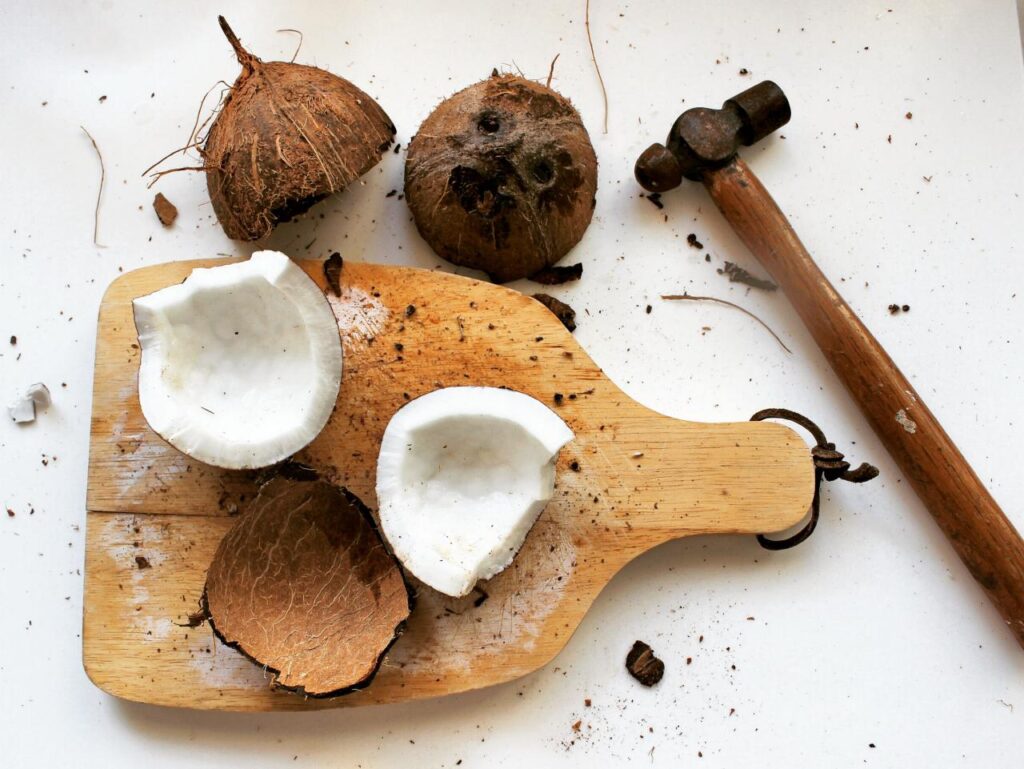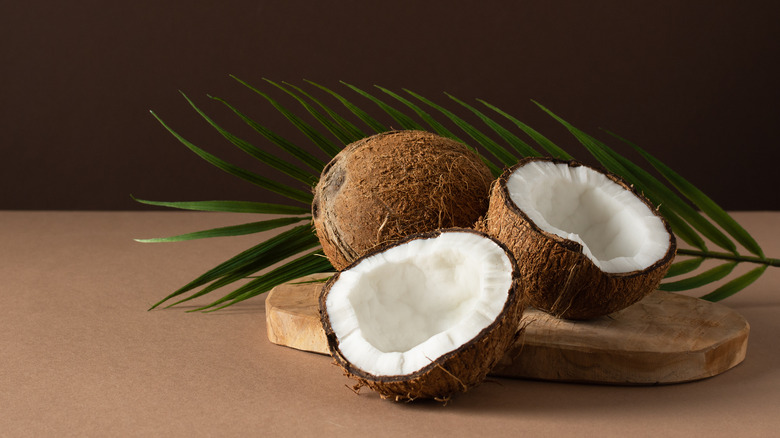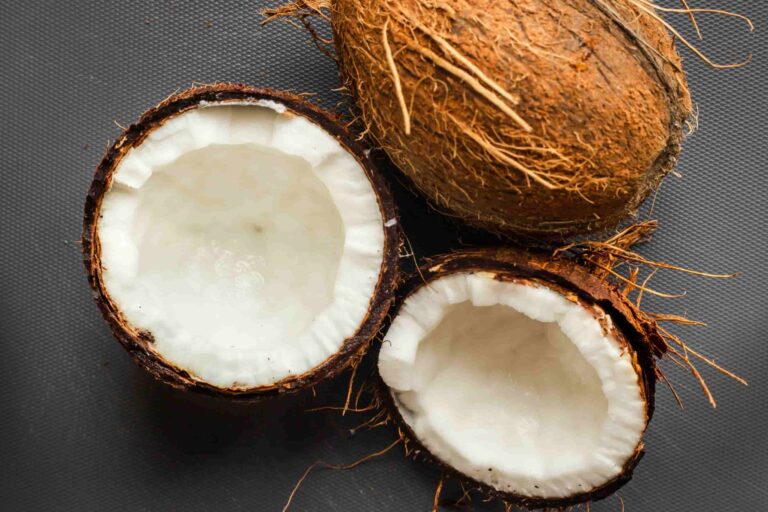No, Coconut skin, referring to the tough and fibrous outermost layer of the coconut, is generally not recommended for direct consumption due to its challenging texture and potential digestive discomfort.
While it may not be toxic, it is not commonly eaten, and coconut skin has limited culinary uses. It is advisable to focus on consuming the more edible and nutritious parts of the coconut, such as the meat (coconut flesh) and water.
Understanding Coconut Components
A. Different Parts of a Coconut
To understand the culinary potential of coconut skin, it’s essential to familiarize ourselves with the various components of a coconut:
Husk: The outermost layer of a coconut is the husk, which is composed of tough, fibrous material. This is the part that is typically removed before coconuts are sold in stores. The husk protects the inner layers of the coconut.
Shell: Beneath the husk lies the coconut shell, a hard and woody layer that encases the innermost parts of the fruit. The shell is what most people envision when they think of a coconut’s exterior.
Meat: The meat of the coconut refers to the thick, white, and fleshy part that is commonly eaten or used in cooking.
Water: Inside the coconut, you’ll find coconut water, a clear and refreshing liquid with a mildly sweet taste. Coconut water is a popular beverage and is often consumed as a hydrating drink.
B. Culinary Uses of Each Component

Husk: The husk itself is not typically consumed, as it is tough and fibrous. However, it can be repurposed in various ways. In some cultures, coconut husk fibers are used for making rope mats and even as a potting medium for orchids and other plants.
Shell: The coconut shell can be repurposed into various decorative and functional items, such as bowls, cups, utensils, or even charcoal for grilling.
Meat: The coconut meat is the most commonly used part of the coconut in cooking. It can be shredded, grated, or ground into coconut flakes or coconut milk, and it is used in a wide range of dishes, including curries, desserts, and baked goods.
Water: Coconut water is a popular beverage enjoyed for its natural sweetness and hydrating properties. It can be consumed fresh, used as a base for smoothies, or added to various recipes for its unique flavor.
While coconut skin (referring to the husk and shell) is not typically consumed directly due to its tough and fibrous nature, it can still have culinary and practical uses, as mentioned above.
The real culinary treasure lies in the coconut meat and water, which offer a plethora of delicious and refreshing options for those looking to incorporate coconut into their diets.
Exploring Coconut Husk (Skin)
A. Physical Characteristics of the Coconut Husk or Skin
The coconut husk, also known as the coconut skin, is the tough, fibrous outermost layer of the coconut. Its physical characteristics include:
Texture: The husk has a coarse and fibrous texture. It consists of long, stiff, densely packed fibers forming a protective layer around the inner coconut components.
Color: Coconut husks are typically brown or tan in color, although the exact shade can vary depending on factors such as the coconut’s maturity and exposure to environmental elements.
Thickness: The husk is relatively thick and serves as a natural armor, shielding the inner coconut layers from external elements, pests, and damage.
Hardness: While not as hard as the inner shell, the husk is still firm and sturdy. It requires a fair amount of effort to crack or cut through.
B. Challenges Associated with Consuming Coconut Husk
Consuming coconut husk presents several challenges and is generally not a common practice due to the following reasons:
Toughness and Fibrous Nature: The primary challenge is the husk’s tough and fibrous composition. Its texture makes it difficult to chew or digest, making it an impractical choice for direct consumption.
Limited Culinary Uses: Unlike other parts of the coconut, such as the meat and water, the husk’s culinary uses are limited. Its primary role is to protect the coconut’s inner components rather than being a source of food.
Potential Digestive Issues: Ingesting coconut husk in large quantities may lead to digestive discomfort and could potentially pose a choking hazard due to its fibrous nature.
Unappealing Flavor: The flavor of coconut husk is generally considered unappealing and lacks the sweetness and mildness associated with other parts of the coconut.
Practical Repurposing: Instead of consuming coconut husk, it is often repurposed for non-culinary uses, such as making ropes, mats, and other crafts, as mentioned earlier.
Edibility of Coconut Skin
A. Safety of Eating Coconut Skin
Coconut skin, referring to the tough, fibrous outermost layer of the coconut, is generally not considered safe or advisable for direct consumption.
Its coarse and fibrous texture makes it difficult to chew and digest, potentially leading to digestive discomfort or even choking, especially when ingested in large quantities.
While coconut skin is not known to be toxic or harmful when consumed in small amounts, it is not a common or recommended part of the coconut to include in one’s diet.
B. Nutritional Content of Coconut Skin
Coconut skin is not typically consumed for its nutritional content because it is primarily composed of tough fibers that are challenging to digest.
As a result, it does not offer significant nutritional benefits that are readily accessible to the human digestive system. The primary nutritional value of the coconut lies in its inner components, such as the meat (coconut flesh) and water.
Coconut meat, for example, is a rich source of dietary fiber, healthy fats, vitamins, and minerals (including potassium, manganese, and copper).
Coconut water is known for its hydrating properties and contains electrolytes like potassium and sodium, making it a natural and refreshing beverage.
Culinary Uses Coconut Skin
A. Traditional or Regional Culinary Practices Involving Coconut Skin
While coconut skin is not commonly consumed in most culinary practices due to its tough and fibrous nature, there are a few traditional or regional practices where it is utilized in specific ways:
Coconut Husk Crafts: In some tropical regions with abundant coconuts, the husk (coconut skin) is repurposed for crafts and practical applications. Due to its durability and resilience, it is often used to make items such as ropes, mats, brushes, and baskets.
Animal Feed: In certain agricultural settings, coconut husks may be used as animal feed or bedding material for livestock, particularly when other resources are limited.
B. Creative Recipes or Dishes Incorporating Coconut Skin
While coconut skin is not a common ingredient in culinary recipes, creative ways exist to incorporate it into dishes. One such approach is to use finely shredded or grated coconut skin as a decorative garnish. Here’s a simple recipe idea:
Coconut Skin Garnish for Desserts
Ingredients:
- Finely grated or shredded coconut skin (from young coconuts)
- Desserts such as cakes, puddings, or fruit salads
Instructions:
- Ensure that you have thoroughly cleaned and peeled the coconut skin to remove any remaining husk fibers.
- Grate the coconut skin into small, thin strips using a fine grater.
- Toast the grated coconut skin in a dry pan over low heat until it turns lightly golden and crispy. This can enhance its texture and flavor.
- Sprinkle the toasted coconut skin over your favorite desserts just before serving to add a unique and decorative touch.
- Please note that this garnish primarily serves an aesthetic purpose and may not significantly alter the flavor or texture of the dish.
- It is essential to use coconut skin from young coconuts, as the husk of mature coconuts tends to be excessively tough and fibrous for culinary use.
Health Considerations of Consuming Coconut Skin
A. Potential Health Benefits or Drawbacks of Consuming Coconut Skin
When it comes to consuming coconut skin, you must consider both its potential benefits and drawbacks:
Potential Benefits:
Dietary Fiber: Coconut skin contains dietary fiber, which can contribute to digestive health by promoting regular bowel movements and potentially aiding in weight management.
Potential Drawbacks:
Digestive Challenges: The primary drawback of consuming coconut skin is its tough and fibrous texture, which can be difficult to chew and digest.
Ingesting large quantities of coconut skin may lead to digestive discomfort, including indigestion, bloating, or even a risk of choking.
Limited Nutritional Value: While coconut skin may contain some trace nutrients, it’s tough nature makes it a significant source of nutrition impractical. The primary nutritional benefits of coconut are found in its meat (flesh) and water.
B. Digestive Concerns or Discomfort Associated with Eating Coconut Skin
Eating coconut skin can potentially lead to digestive concerns or discomfort, primarily due to its fibrous and indigestible nature:
Difficulty Chewing and Swallowing: The coarse and tough texture of coconut skin can make it challenging to chew thoroughly, increasing the risk of swallowing larger, less digestible pieces.
Digestive Discomfort: Ingesting coconut skin may cause digestive discomfort, such as indigestion, gas, or bloating. This is because the body may struggle to break down and process the fibrous material.
Choking Hazard: The fibrous strands of coconut skin could pose a choking hazard, especially for individuals who have difficulty chewing or swallowing.
Crafting and Practical Uses of Coconut Skin
A. Alternative Uses of Coconut Husk
Coconut husk, with its durable and fibrous composition, finds a variety of practical applications beyond the culinary realm. Here are some alternative uses:
Crafting: Coconut husk fibers are prized for their strength and resilience. They are commonly used to craft various items such as ropes, mats, brushes, baskets, and decorative ornaments.
The husk’s natural texture and durability make it a versatile material for artisans and craftsmen.
Gardening: Coconut coir, which is the fibrous material extracted from the coconut husk, is a popular choice in gardening.
- It is used as a substrate for potting plants, as a component of seed-starting mixes, and as a soil conditioner.
- Coconut coir is valued for its water retention capabilities, aeration properties, and sustainability.
Erosion Control: Coconut coir is also employed for erosion control in landscaping and environmental restoration projects. It helps stabilize soil and prevent erosion on slopes and riverbanks.
B. DIY Projects and Gardening Tips Involving Coconut Husk
- Coconut Coir Potting Mix: Create a potting mix by mixing coconut coir with potting soil. This mix improves water retention and aeration in potted plants. It’s especially useful for container gardening.
- Coconut Fiber Doormat: Make a doormat by binding coconut fibers together with a sturdy backing. This natural, biodegradable doormat is not only functional but also eco-friendly.
- Coconut Husk Bird Feeder: Craft a bird feeder by hollowing out a coconut half and attaching a sturdy string for hanging. Fill the coconut half with birdseed and hang it in your garden to attract feathered visitors.
- Coconut Coir Mulch: Use coconut coir as mulch in your garden beds to help retain moisture, suppress weeds, and improve soil quality.
- Seed Starter Pots: Create biodegradable seed starter pots by shaping coconut coir into small pots. Plant seeds directly in these pots, and once the seedlings are ready for transplant, place the entire pot in the ground.
- Erosion Control Matting: If you have a slope prone to erosion, use coconut coir erosion control matting. Lay it on the slope, secure it with stakes, and it will help stabilize the soil.
- Composting: Coconut husk can be added to compost bins or piles to improve aeration and moisture retention. It’s a valuable addition to your composting efforts.
Safety and Precautions While eating the Coconut Skin

A. Safety Tips for Experimenting with Eating Coconut Skin
If someone decides to experiment with eating coconut skin despite its tough and fibrous nature, it’s essential to take some safety precautions:
Clean Thoroughly: First off, thoroughly clean the coconut skin and remove the dirt, debris, and residual husk fiber from it.
Small Portions: Start with very small portions to test your tolerance and see how your digestive system responds.
Chew Carefully: Chew the coconut skin thoroughly and slowly to break down the tough fibers as much as possible before swallowing.
Stay Hydrated: Drink plenty of water while consuming coconut skin to aid digestion and prevent any potential choking hazards.
Monitor for Discomfort: Pay attention to any signs of digestive discomfort or other health issues such as bloating, gas, or indigestion. If you experience discomfort, stop consuming coconut skin immediately.
Limit Consumption: Due to its challenging texture, limiting the consumption of coconut skin and not making it a regular part of your diet is advisable.
B. Importance of Properly Cleaning and Processing Coconut Husk
If you intend to use coconut husk for any culinary or crafting purposes, it is crucial to follow proper cleaning and processing procedures:
- Cleaning: Thoroughly clean the coconut husk by removing any dirt, debris, or husk fibers. Rinse it under running water and scrub if necessary.
- Drying: Allow the cleaned coconut husk to dry completely to prevent mold or bacterial growth.
- Processing: For crafting purposes, you may need to further process the husk by cutting, shredding, or grinding it to the desired texture.
- Gardening: When using coconut coir (fibers extracted from the husk) in gardening, ensure it has been properly prepared and is free from any contaminants.
- Storage: Store processed coconut husk or coir in a dry and well-ventilated area at your home to prevent moisture buildup.
- Hygiene: Practice good hygiene when handling coconut husk, especially if you plan to use it in crafting or gardening, to avoid any potential skin irritations.
FAQs
Can you eat coconut skin?
No, a coconut’s tough outer husk or skin is not typically consumed, as it is fibrous and challenging to digest.
Is the inner white flesh of the coconut edible?
Yes, the white flesh of the coconut, known as the coconut meat, is edible and widely used in cooking and baking.
Can you eat the brown layer of skin on the coconut meat?
Yes, the thin brown layer adhering to the coconut meat is edible and is often left on when using coconut meat in recipes.
Is coconut water safe to drink?
Yes, coconut water inside the coconut is safe to drink and a natural source of hydration.
Are there any culinary uses for coconut skin?
No, coconut skin is generally not used in cooking or culinary applications due to its tough texture.
Can coconut skin be used for crafting or other purposes?
Yes, coconut husk or skin is used for crafting, making ropes, and as a natural plant potting material.
Is coconut skin used in traditional medicine or remedies?
Yes, in some traditional practices, coconut husk extracts are used for medicinal purposes, such as treating various ailments.
Is it safe to chew on coconut skin for oral health?
No, chewing on coconut skin is not recommended for oral health, as it can be abrasive and may harm teeth and gums.
Can eating coconut skin cause digestive issues?
Yes, consuming coconut skin can lead to digestive discomfort and is generally avoided.
Is it necessary to remove coconut skin before eating the inner meat?
Yes, removing the tough outer skin or husk is advisable to access and enjoy the inner edible coconut meat safely.
Conclusion
Coconut skin, though not commonly consumed as a direct part of the diet, offers versatility in crafting, gardening, and even creative culinary applications.
While it can be experimented with, caution is advised due to its challenging texture and potential digestive discomfort.
Our final recommendation is to prioritize the coconut’s more commonly enjoyed and nutritious parts, such as the meat and water, for culinary purposes.
If you decide to experiment with coconut skin, do so in small quantities, chew it thoroughly, and be mindful of any digestive discomfort.
Whether for crafting, gardening, or culinary curiosity, coconut husk and coir can find valuable and creative uses when handled and processed with care.

